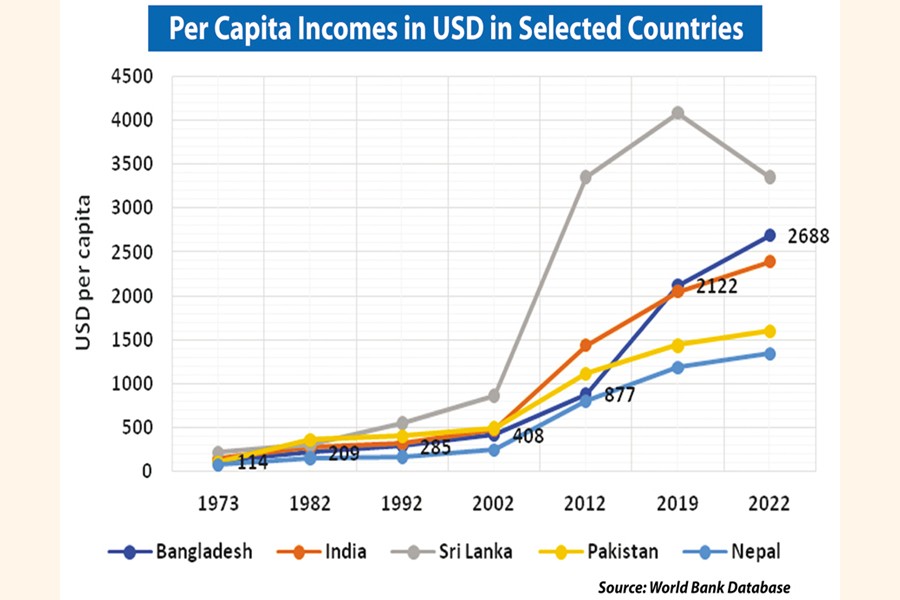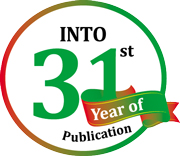
Sight set on middle-income country status
The path strewn with challenges
A K Enamul Haque | Sunday, 10 December 2023

 Bangladesh has made incredible strides in improving its economic standing, particularly in the measurement of per capita income. Per capita income essentially represents the average income earned per person in a country. Back in 1973, each person in Bangladesh, on average, earned around 114 US dollars annually. In 2022 this figure remarkably surged to 2,688 US dollars.
Bangladesh has made incredible strides in improving its economic standing, particularly in the measurement of per capita income. Per capita income essentially represents the average income earned per person in a country. Back in 1973, each person in Bangladesh, on average, earned around 114 US dollars annually. In 2022 this figure remarkably surged to 2,688 US dollars.
To put this into perspective, Bangladesh now boasts the second-highest per capita income among its neighbouring countries, except Sri Lanka. This is a noteworthy achievement, especially when considering the challenges posed by its substantial population. The fact that Bangladesh has managed to significantly boost individual incomes despite having a large population is an impressive feat.
This upward trend in per capita income places Bangladesh in a favourable position on the global stage. It signifies not only economic growth but also an improvement in the standard of living for the people of Bangladesh. The country's success in increasing per capita income showcases its commitment to development and economic prosperity, making it a standout performer in the international community.
In the regional context, Sri Lanka has historically occupied a leading position among its neighbours. However, Bangladesh's economic progress is notable, especially when compared to its South Asian counterparts. Until 2012, Bangladesh had a lower per capita income than India, and until 2002, it lagged behind Pakistan. This means that Bangladesh surpassed Pakistan's per capita income in 2002 and India's in 2012.
The fact that Bangladesh has overtaken these two significant neighbours in terms of per capita income is a testament to the country's economic growth and development. It reflects a positive trend, showcasing Bangladesh's ability to enhance the economic well-being of its citizens over the years.
As Bangladesh progresses on its path to attaining middle-income status, it's crucial to recognise and applaud the strides made in income growth. Yet, it's of equal significance to confront and tackle the challenges that could impede sustained advancement. While conventional discussions on these challenges typically encompass issues such as economic inequality, social development, infrastructure, and population, Bangladesh must navigate these intricacies strategically. Failing to do so might lead to a fate similar to that of Sri Lanka, which experienced negative economic growth over the past decade.
Taking a different perspective, the developmental focus in Bangladesh during the 1970s was primarily on reconstructing infrastructure and extending educational opportunities to rural areas. This emphasis was evident in the government's spending patterns. Transitioning into the 1980s, the focus shifted towards the construction of rural infrastructure, specifically the expansion of roads linking markets and guiding local investments towards agriculture-based development.
Moving into the 1990s, there was another shift in focus, with the government heavily involved in the expansion of rural electrification network. Following advices from international agencies, the country opted for deregulation of the power sector and divided it into three distinct components. The overarching goal was to attract investments into the power sector. Unfortunately, despite these efforts, significant investments failed to materialise during this decade. The Kansat tragedy served as a poignant reminder of the challenges faced. Economic growth till the beginning of 2000s was mostly geared toward rural development and generating employment.
In the 2010s, Bangladesh experienced its most substantial increase in per capita income, primarily propelled by significant investments in urban infrastructure. This surge commenced with substantial private sector involvement in the power sector, followed by the initiation of large-scale public infrastructure projects. Notably, this newfound economic growth has been predominantly concentrated in urban areas, emanating from both public and private mega projects like Padma bridge, Dhaka Elevated Expressway, Dhaka Metrorail Project, etc.
The outcomes of this growth trend include heightened economic expansion, a surge in the urban population, and concurrently, a relatively low rate of employment growth. Despite this characterisation, the fundamental goal behind these urban-centric investments is to stimulate increased investment in urban economies. This objective aligns with the anticipated trajectory of gradual urbanisation that the country is expected to undergo. While the term 'jobless growth' may capture a certain aspect of the reality, the overarching ambition is to foster sustained investment growth within the evolving urban landscape.
Reflecting on the past, the simultaneous achievement of a low population growth rate and a high economic growth rate in Bangladesh carries profound implications for the nation's socio-economic landscape. A low population growth rate signifies that the rate at which the population is expanding has slowed down. This demographic trend is crucial because it has implications for resource distribution, social services, and overall quality of life. A more controlled population growth often allows more efficient allocation of resources, improved education and healthcare services, and a better standard of living for individuals.
Nevertheless, in a nation lacking a public social security system (not social safety net programmes), this trajectory could lead to perilous consequences. With smaller family sizes and the absence of comprehensive and high-quality health coverage, it is foreseeable that a significant crisis may unfold, characterised by a surge in elderly individuals resorting to begging on the streets and a spike in deaths resulting from age-related ailments. This looming scenario poses a substantial social challenge. Fortunately, the government has initiated two policies and programmes aimed at addressing this concern: the 'limited' Universal Pension Scheme and legislation designed to enforce legal obligations on children to provide care for their parents.
The current pension scheme struggles with a lack of popularity, exacerbated by the lukewarm support it receives from the government. The programme's structure is viewed with suspicion, as the success of any public pension scheme hinges on establishing robust public trust. People need assurance that the government will fulfill its commitment to disbursing pensions 20-30 years down the line when they are no longer able to work. This underscores two critical elements: a) the need for a trustworthy authority, led by socially respected figures who can instill confidence in the system, and b) a well-conceived investment plan for the funds managed by the authority. Unfortunately, both of these crucial components are currently lacking in the scheme's current phase.
Compounding the issue is the recent government decision to tax the provident funds of private sector employees, a move which is discriminatory and has potentially devastating consequences. This decision, especially in a context where the government has struggled to expand its taxpayer base, sends a disconcerting message to the public. It implies a lack of confidence in the government's ability to fulfill its pension commitments, as evidenced by the move to tax the savings of private sector employees. This development further erodes the trust necessary for the success of any pension system and raises concerns about the government's commitment to providing financial security for its citizens in their retirement years. My suggestion to the government is to have an independent commission headed by an eminent economist who will gradually restore confidence in the system and make this excellent endeavour of the government a success.
Bangladesh aspires to attain the status of a middle-income country by 2040, a goal that lies only 16 years ahead. Comparatively with Bangladesh, middle-income countries such as China, Russia, Kazakhstan, Turkey, Brazil, South Africa, Argentina, and others showcase a stark contrast in terms of economic management and political stability. On the other hand, India, Sri Lanka, Iran, and others are either already surpassed or expected to be surpassed by Bangladesh in the near future.
These middle-income nations are characterised by efficient governance and a stable political system capable of weathering economic challenges (please note Sri Lanka could not). Their economies are independent and predominantly anchored in manufacturing investments, guided by robust research capabilities. A cursory examination of their urban transportation systems reveals well-organised and efficient infrastructure.
However, in Bangladesh, many major cities still lack a comprehensive public transportation system. Even in cities like Dhaka and Chattogram where such systems exist, the streets are cluttered with buses in disarray due to reckless driving or the absence of strict traffic regulations - a testament to our governance quality at the bottom. This raises pertinent questions about whether these images go with the expectation of achieving the middle-income economy status.
Bangladesh must prioritise developing a robust public transportation system, implementing effective traffic rules, and improving governance to emulate the success of middle-income countries. These changes are not just symbolic but essential for efficient urban infrastructure, crucial for achieving the middle-income country status and enhancing overall quality of life. A solid governance foundation is imperative to attract investments, preventing local investors from seeking refuge abroad and abandoning national passports.
Professor A K Enamul Haque, an economist, teaches economics at the East West University in Dhaka. akehaque@ewubd.edu